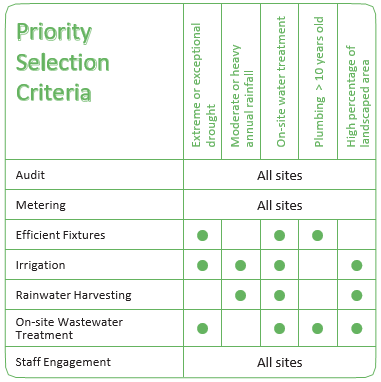Strategy Selection Factors
After water end uses have been identified, the facility team should evaluate the unique characteristics of the local climate to determine which strategies in this chapter make the most sense to implement.
Upgrades and retrofits can be prioritized based on the following criteria:
- Extreme or exceptional drought: Many parts of the world are in a state of drought (Figure 4). In the 36 months from January 2010 to 2013, drought affected 172 million people.6 Sites located in one of the areas highlighted as experiencing extreme or exceptional drought should explore all conservation options.
Figure 4: Global drought monitor, based on rainfall data during an assessment period from January 1955 to January 2018

- Moderate or heavy annual rainfall: Sites with consistent rainfall throughout the year can typically utilize rain catchment systems to supply irrigation and building uses, and offset municipally-provided water or water from other sources.
- On-site water treatment: Many sites do not have adequately reliable, municipally-sourced and -treated water supply or sanitary sewer systems. These sites may rely on trucks to transport potable water to the site; on wells with limited supplies; or on in-house treatment systems that have substantial operations, maintenance, and energy impacts. Intensive operations can make water reduction financially attractive. Where on-site WWT facilities exist, it is advisable to upgrade systems so that treated effluent can be reused for irrigation. At sites where WWT facilities don’t exist or future WWT could be installed, consider constructed wetlands for tertiary treatment and infiltration.
- Plumbing more than ten years old: If a building’s plumbing fixtures have not been upgraded or replaced within the last ten years, they are less efficient than newer fixtures commercially available today. Upgrades to fixtures and irrigation systems can result in 20–30% water savings.
- High percentage of landscaped area: When irrigated landscape and turf areas cover the majority of site areas, there are likely opportunities to replace turf and water-intensive plantings with non-irrigated, native, drought-tolerant species or low-maintenance gravel.


